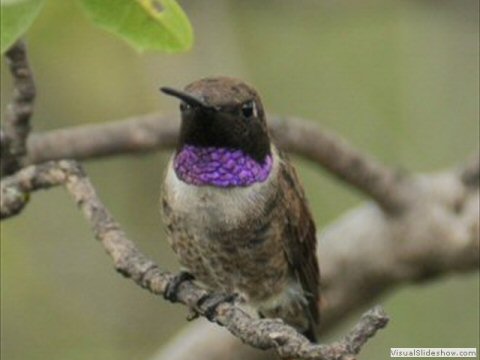

Black-chinned HummingbirdArchilochus alexandri | |
|
Widespread as a breeding species throughout the western United States, areas of western Canada, and much of northern Mexico, the Black-chinned Hummingbird was first recorded in Louisiana in Baton Rouge in the 1950s. From then until the mid-1970s, a few more records accrued. By the mid 1980s, Black-chinneds occurred annually. In some years, they may appear in considerable numbers, whereas in others winter seasons their population in the state is quite reduced. In the early years of research on wintering hummingbirds, Black-chinneds seemed to outnumber Ruby-throateds by about 5 to 1, but more recently, their numbers are nearly equal. No reason is apparent for this dramatic population shift. Sightings have been recorded from early September to early May, with peak numbers being detected around Christmas. While members of this species have been reported from many parts of the state, the southeastern section seems to attract or hold more. As many as 6 individuals have been documented to occur at a single site at one time. On their Louisiana wintering grounds, Black-chinned Hummingbirds prefer habitats with oaks, and especially Live Oaks. However, even where conditions seem perfect, Black-chinned Hummingbirds may be less territorial than Rufous Hummingbirds, and they may be forced to roam around. Still, some individuals return to sites where they wintered in previous years – 6 years in one instance. This species is a close relative of (and the western counterpart to) our Ruby-throated Hummingbirds. Adult Male: The nape and back are glittering dark green, the crown duller. The gorget [throat] is velvety black, bordered below by a band of iridescent violet. Violet can only be seen if the bird is facing the observer and if the light source is directly behind the observer. The wings are blackish brown. The underparts are dirty, whitish gray, cleanest-looking just below the gorget, and heavily overlaid with dark green on the sides and flanks. The two central tail feathers are the same glittering green as the back. The outer eight tail feathers are dull black. The outermost tail feathers are much longer than the central ones, giving the tail a deeply notched shape. The bill is black and about one and one third times the length of the head. Adult Female: The nape and back are glittering dark green, sometimes shading to yellowish green. The crown is dull, rather grayish. The wings are brownish black. The throat, breast, and belly are dingy, whitish gray, sometimes with dark grayish streaks or spots on the throat. The two central tail feathers are the same glittering dark green as the back. The outer eight tail feathers are greenish gray at the base with a wide black band. The three outermost tail feathers on each side have white tips. The fourth [from center] tail feathers are longer than the central and the outer ones, which makes the tail appear to be rounded on each side. The bill is black, about one and one half times the length of the head, and it is often slightly decurved. Immatures: This plumage closely resembles that of the adult female except that the green of the back and rump does not shade to yellowish green. Brownish margins on each back feather usually make the back appear much more dull than that of an immature male Ruby-throated. The throat of young males may show a varied amount of green or grayish streaking or spotting. A few iridescent violet feathers may be present on the throat. Young females closely resemble adult females, which never show any violet on the throat. Ruby-throateds and Black-chinneds are extremely similar in appearance. Ornithologists rely on measurements of the bill, wing, and tail, as well as the shapes of certain wing feathers to distinguish immature and female birds to species. In the field, trained observers note subtle differences in coloring and some differences in behavior when identifying these two species. Their vocalizations, a soft ‘tchew’, are very similar. Black-chinned wings give a more pronounced ‘whir’ than those of Ruby-throateds. |
 Adult male Black-chinned Hummingbird |